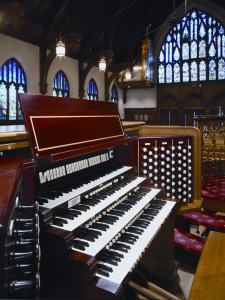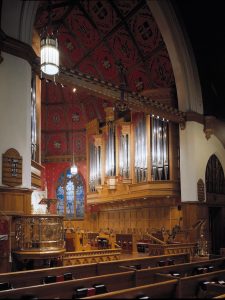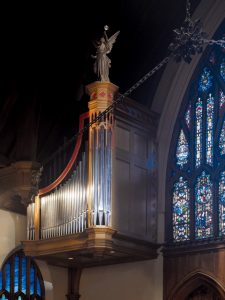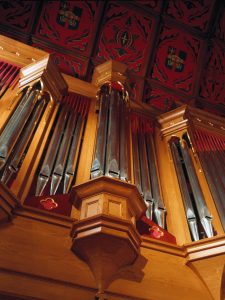All Saints Episcopal Church
Atlanta, Georgia
Completed 2003
63 stops, 87 ranks, four manuals and pedal
It has been a high honor to have been commissioned to design and build this exciting musical instrument for All Saints Church. During the last year, three large downtown Atlanta churches commissioned important new pipe organs. The fact that the All Saints organ is the only one of the three to be built by an American organbuilder made the honor of our selection all the more gratifying, but also added pressure upon us to perform at the highest possible level of organbuilding.
When first approached by Assistant Organist Jefferson McConnaughey some years ago concerning the design of this instrument, we were just becoming known in the organ world as a builder whose tonal style was very much inspired by the great organs in the English cathedrals. As our discussions evolved, and as Music Directors and Organists Raymond and Elizabeth Chenault became directly involved in the design, it quickly became apparent that all of us were of the same mind concerning the organ’s tonal and physical disposition. This instrument had to be eclectic to perform a wide range of music, but had to have tremendous personality and character. The stops all had to have vivid individual tone-color, but had to blend and balance each other seamlessly.
Stop List
8′ First Open Diapason
8′ Second Open Diapason (ext. 16′ Double)
8′ Viola da Gamba
8′ Harmonic Flute
8′ Bourdon
4′ Principal
4′ Spire Flute
2 2/3′ Twelfth
2′ Fifteenth
2′ Harmonic Mixture IV
16′ Double Trumpet
8′ Tromba (Pd) (ext. 16)
4′ Clarion (Pd) (ext. 16′)
Tremulant
8′ Major Tuba (15″ wind)
8′ Tuba Solo Melody Coupler
8′ Fanfare Trumpets (Ap)
Chimes
8′ Stopped Diapason (stoppered wood)
8′ Salicional
8′ Voix Celeste (TC)
4′ Principal
4′ Harmonic Flute
2 2/3′ Nazard (tapered)
2′ Flageolet (harmonic)
2 2/3′ Full Mixture V
8′ Trompette (modified French style)
8′ Oboe (English style)
8′ Vox Humana (English style)
4′ Clarion (ext. 16′)
Tremulant
8′ Major Tuba (Gt)
8′ Fanfare Trumpets (Ap)
8′ Open Diapason
8′ Aeoline
8′ Vox Angelica (TC)
4′ Principal
8′ English Diapason
8′ Flûte à Bibéron (stoppered wood)
8′ Gedeckt Flute (ext. 16′ Lieblich)
8′ Dulciana
8′ Unda Maris (TC)
4′ Principal
4′ Koppel Flute
2′ Recorder
2′ Mixture III-IV
1 1/3′ Fourniture IV
16′ English Horn (double bells)
8′ Cornopean
8′ Clarinet
Tremulant
8′ Major Tuba (Gt)
8′ Fanfare Trumpets (Ap)
Cymbalstern, 14 Bells
Harp, Walker Unison percussion
Celesta, Walker Octave percussion
8′ Viola da Gamba
8′ Gamba Celeste (CC)
8′ Melodia
8′ Flute Coelestis II
4′ Principal
4′ Flûte d’ Amour
2′ Doublette
1 1/3′ Mixture IV
8′ Flügal Horn
8′ Corno di Bassetto
Tremulant
8′ Major Tuba (Gt)
Cymbalstern
Harp. Walker Unison percussion
Celesta, Walker Octave percussion
Chimes (Gt)
32′ Subbass
32′ Lieblich Gedeckt
16′ First Open Diapason
16′ Second Open Diapason (Gt)
16′ Bourdon (stoppered wood)
16′ Lieblich Gedeckt (Ch)
8′ Principal (tin façade)
8′ Bass Flute (ext. 16′ Bourdon)
8′ Gedeckt Flute (Ch)
4′ Choral Bass
2 2/3′ Mixture IV
32′ Contra Trombone
16′ Trombone
16′ Double Trumpet (Gt)
16′ Bassoon (Sw)
8′ Trumpet (ext. 16′ Trombone)
4′ Clarion (Sw)
8′ Major Tuba (Gt)
8′ Fanfare Trumpets (Ap)
Find more information about his new CD at this link!
About the Organ: From the Organbuilder
It was a high honor to have been commissioned to design and build this exciting musical instrument for All Saints Church. During the year in which this organ was commissioned, three large downtown Atlanta churches built important new pipe organs. The fact that the All Saints organ is the only one of the three to be built by an American organbuilder made our selection all the more gratifying, but also added pressure to perform at the highest possible level of American organbuilding.
When first approached by then Assistant Organist Jefferson McConnaughey concerning the design of this instrument, we were just becoming known in the organ world as a builder whose tonal style was very much inspired by the great organs in England and the Continent. As our discussions evolved, and as Music Directors and Organists Raymond and Elizabeth Chenault became directly involved in the design, it quickly became apparent that all of us were of the same mind concerning the organ’s tonal and physical disposition, and the uses to which the organ would be put. This instrument had to perform a wide range of music, but had to have tremendous personality and character. The stops all had to have vivid individual tone-colors, but had to blend and balance each other seamlessly and in multiple contexts.
All Saints is a large parish whose musical requirements are every bit as demanding upon its instrument (and its musicians) as a large metropolitan cathedral. This organ is essentially what I think a modern American Cathedral Organ ought to be. Although inspired by English Cathedral organs of certain builders, this is not an English Organ. This is an instrument which embraces our American musical sensibilities and is truly original, not derivative. In broad terms, the organ has to play a wide variety of literature, and support worship through accompanying and leading congregational singing. Scholarship in the design tells us that stops of certain tonal qualities need to be in specific locations in the organ in order to work properly in the many contexts in which we expect them to be used.
Because this is a large instrument, we had the opportunity to include a wealth of soft stops to increase the organ’s accompanimental flexibility and dynamic range. We were able to include an entire chorus of soft Diapason-toned Dulcianas in the Choir Organ, along with lyric cantabile reeds and two celeste stops in the Solo Organ. In the Chapel Organ, besides a pair of 8’ and 4’ Principals for hymn-singing, we included a pair of very soft string-toned stops, an Aeoline and Vox Angelica, the likes of which haven’t been seen in organ specifications for many years. We were able to re-introduce a Harmonic Mixture to the Great Organ, whose primary function is to reinforce the higher harmonics of the flue work when the relatively dark Trombas are used, by virtue of the inclusion of the tierce and flat-seventh ranks. We have come to find, through its musically sensitive scaling and voicing, the Harmonic Mixture also adds an ancient Continental flavor to the Great plenum without the Trombas.
The visual design of the organ was a very crucial element to its success. We were challenged to design and build an organ of about three times the size as the former instrument – and make it look as though it had always been at home in the Church. I enjoyed working with Hugh Latta, a parishioner and respected interior designer, concerning the stain colors and the Chapel Organ’s design. We were all privileged to work with architects Jim Chapman and Jim Macht on the platforms used to support the organ cases, and with parishioner and then Senior Warden Paul Elliott in his role of coordinating our efforts with those of local contractors and woodworkers.
It’s an honor for us that Ray Chenault has chosen to record his favorite organ pieces on this instrument. The fact that this organ can musically render French and Belgian repertoire, then accompany the choral repertoire of the Anglican Musical Tradition on a Sunday points to the special nature of our work in which science and craft always serve the musical ideal. In this way we hope that our instruments are seen as works of functional art by those who enjoy them.
John-Paul Buzard
Here is the review of the NEW CD – Concert Favorites by Raymond Chenault issued by Gothic
This collection of mostly French and Belgian organ repertoire (the Dutch Hendrik
Andriessen being the lone exception), primarily drawn from the 20th century, is one of those
marvelous, unexpected delights that lights up a music reviewer’s life. First, it intelligently brings
together 18 shorter works by 14 composers (Dupré, Dubois, Langlais, and Messiaen have two
selections apiece; in addition, Duruflé appears indirectly, as an arranger of the piece by
Tournemire), most abstracted from larger sets, into a varied and yet stylistically unified and
aesthetically satisfying program that provides a first-rate entry into and overview of a broad
swath of important but mostly seldom recorded repertoire. Second, the performances by
Raymond Chenault—organist and choirmaster of All Saints’ Episcopal Church in Atlanta since
1975—are simply magnificent, perfectly gauged down to even the smallest details for absolute
rightness of tempos, rhythmic precision, sculpting of phrases, an unerring and vibrant sense of
timbres in use of registrations and stops, and interpretive voice for each and every composer.
(Chenault is so good that he actually had me enjoying the two pieces of Messiaen, whose music I
normally detest.) Third, there is the instrument itself, the James G. Kenan Memorial Organ that
is the op. 29 of John-Paul Buzard Pipe Organ Builders. Completed in 2003, this massive
instrument—63 stops, 87 ranks, and 5,143 pipes, including five 32-foot pipes for the pedal
division—replaced one only about one-third its size and is exceptional for both its power, range
of tonal colors, and adaptability to widely varying types of repertoire, and is ideally adapted to its
acoustical environment. Fourth, there is the rich, full-bodied, yet absolutely clear recorded sound
secured by Gothic for this release. Fifth and last but hardly least, there are the extremely wellwritten
booklet notes by Chenault about the music and Buzard about the organ, accompanied by
an array of color photographs. The fold-out digipak houses the two CDs in opposing wings and
slips the booklet into a cardboard sleeve rather than a plastic tray in the center, all adorned with
yet more color photos. This is a model release of the highest quality on every level, in every way;
recommended with unqualified enthusiasm! James A. Altena













